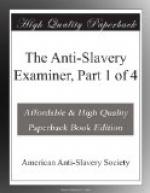1. “Thou hast made him a little lower than the angels.” Slavery drags him down among brutes.
2. “And hast crowned him with glory and honor.” Slavery tears off his crown, and puts on a yoke.
3. “Thou madest him to have dominion OVER the works of thy hands.” Slavery breaks his sceptre, and casts him down among those works—yea, beneath them.
4. “Thou hast put all things under his feet.” Slavery puts HIM under the feet of an owner, with beasts and creeping things. Who, but an impious scorner, dare thus strive with his Maker, and mutilate HIS IMAGE, and blaspheme the Holy One, who saith to those that grind his poor, “Inasmuch as ye did it unto one of the least of these, ye did it unto me.”
But time would fail us to detail the instances in which this distinction is most impressively marked in the Bible.
In further prosecuting this inquiry, the Patriarchal and Mosaic systems will be considered together, as each reflects light upon the other, and as many regulations of the latter are mere legal forms of Divine institutions previously existing. As a system, however, the latter alone is of Divine authority. Whatever were the usages of the patriarchs, God has not made them our examplars[A].
[Footnote A: Those who insist that the patriarchs held slaves, and sit with such delight under their shadow, hymning the praises of “those good old patriarchs and slaveholders,” might at small cost greatly augment their numbers. A single stanza celebrating patriarchal concubinage, winding off with a chorus in honor of patriarchal drunkenness, would be a trumpet call, summoning from bush and brake, highway and hedge, and sheltering fence, a brotherhood of kindred affinities, each claiming Abraham or Noah as his patron saint, and shouting, “My name is legion.” What a myriad choir, and thunderous song!]




